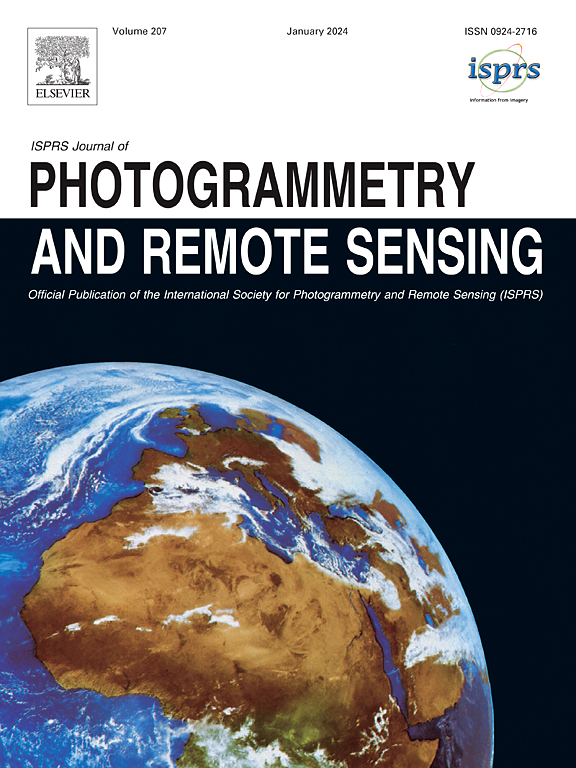PylonModeler:一种混合驱动的基于LiDAR点云的输电塔三维重建方法
IF 10.6
1区 地球科学
Q1 GEOGRAPHY, PHYSICAL
ISPRS Journal of Photogrammetry and Remote Sensing
Pub Date : 2025-02-01
DOI:10.1016/j.isprsjprs.2024.12.003
引用次数: 0
摘要
由于电网是现代社会不可或缺的基础,因此创建电网的数字孪生体具有重要意义。输电塔作为输电走廊的组成部分,其精确的三维重建对电网的安全运行至关重要。然而,由于数据质量和塔结构的多样性和复杂性,激光雷达点云的三维塔重建面临着许多挑战。为了应对这些挑战,我们引入了PylonModeler:一种使用机载激光雷达点云进行3D塔重建的混合驱动方法,从而实现准确、稳健、高效的实时塔重建。采用不同的策略来实现不同结构的独立重建和组装。我们提出了一种用于实时铁塔识别和分解的轻量级变压器网络——铁塔前网络。随后,我们应用数据驱动的方法进行塔体重建。考虑结构特征,采用拟合和聚类算法重构外部和内部结构。采用混合方法重建塔头。预建的塔头参数模型库通过一系列参数定义不同的塔。采用相干点漂移(CPD)算法建立塔头结构之间的拓扑关系,设置初始模型参数,通过优化对模型参数进行细化,实现塔头的精确重建。最后将塔身模型与塔头模型结合,完成重建。我们收集了一个机载激光雷达数据集,其中包括8种类型的3398个塔数据。数据集包括110 kV、220 kV和500 kV等不同电压等级的输电线路。在此数据集上验证PylonModeler。平均重建时间为1.10 s,平均重建精度为0.216 m。此外,我们评估了PylonModeler在卢森堡公共机载LiDAR数据上的性能。与之前最先进的方法相比,重建精度提高了约26.28%。PylonModeler具有卓越的性能,比当前的模型驱动方法快几十倍,可以实现实时的pylon重建。本文章由计算机程序翻译,如有差异,请以英文原文为准。
PylonModeler: A hybrid-driven 3D reconstruction method for power transmission pylons from LiDAR point clouds
As the power grid is an indispensable foundation of modern society, creating a digital twin of the grid is of great importance. Pylons serve as components in the transmission corridor, and their precise 3D reconstruction is essential for the safe operation of power grids. However, 3D pylon reconstruction from LiDAR point clouds presents numerous challenges due to data quality and the diversity and complexity of pylon structures. To address these challenges, we introduce PylonModeler: a hybrid-driven method for 3D pylon reconstruction using airborne LiDAR point clouds, thereby enabling accurate, robust, and efficient real-time pylon reconstruction. Different strategies are employed to achieve independent reconstructions and assemblies for various structures. We propose Pylon Former, a lightweight transformer network for real-time pylon recognition and decomposition. Subsequently, we apply a data-driven approach for the pylon body reconstruction. Considering structural characteristics, fitting and clustering algorithms are used to reconstruct both external and internal structures. The pylon head is reconstructed using a hybrid approach. A pre-built pylon head parameter model library defines different pylons by a series of parameters. The coherent point drift (CPD) algorithm is adopted to establish the topological relationships between pylon head structures and set initial model parameters, which are refined through optimization for accurate pylon head reconstruction. Finally, the pylon body and head models are combined to complete the reconstruction. We collected an airborne LiDAR dataset, which includes a total of 3398 pylon data across eight types. The dataset consists of transmission lines of various voltage levels, such as 110 kV, 220 kV, and 500 kV. PylonModeler is validated on this dataset. The average reconstruction time of a pylon is 1.10 s, with an average reconstruction accuracy of 0.216 m. In addition, we evaluate the performance of PylonModeler on public airborne LiDAR data from Luxembourg. Compared to previous state-of-the-art methods, reconstruction accuracy improved by approximately 26.28 %. With superior performance, PylonModeler is tens of times faster than the current model-driven methods, enabling real-time pylon reconstruction.
求助全文
通过发布文献求助,成功后即可免费获取论文全文。
去求助
来源期刊

ISPRS Journal of Photogrammetry and Remote Sensing
工程技术-成像科学与照相技术
CiteScore
21.00
自引率
6.30%
发文量
273
审稿时长
40 days
期刊介绍:
The ISPRS Journal of Photogrammetry and Remote Sensing (P&RS) serves as the official journal of the International Society for Photogrammetry and Remote Sensing (ISPRS). It acts as a platform for scientists and professionals worldwide who are involved in various disciplines that utilize photogrammetry, remote sensing, spatial information systems, computer vision, and related fields. The journal aims to facilitate communication and dissemination of advancements in these disciplines, while also acting as a comprehensive source of reference and archive.
P&RS endeavors to publish high-quality, peer-reviewed research papers that are preferably original and have not been published before. These papers can cover scientific/research, technological development, or application/practical aspects. Additionally, the journal welcomes papers that are based on presentations from ISPRS meetings, as long as they are considered significant contributions to the aforementioned fields.
In particular, P&RS encourages the submission of papers that are of broad scientific interest, showcase innovative applications (especially in emerging fields), have an interdisciplinary focus, discuss topics that have received limited attention in P&RS or related journals, or explore new directions in scientific or professional realms. It is preferred that theoretical papers include practical applications, while papers focusing on systems and applications should include a theoretical background.
 求助内容:
求助内容: 应助结果提醒方式:
应助结果提醒方式:


